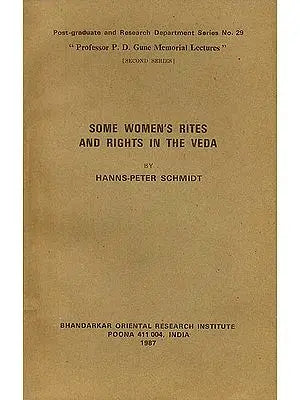Some Women's Rites and Rights in The Veda (An Old and Rare Book)
Some Women's Rites and Rights in The Veda (An Old and Rare Book)
Paperback
Couldn't load pickup availability
Publisher : Bhandarkar Oriental Research Institute, Pune
Author : Hanns-Peter Schmidt
Language : English
Edition : 1987
Pages : 142
Cover : Paperback
Dimension : 21.5 cm X 14 cm
Weight : 150 gm
The Apala-sakta is generally considered as one of the popular hymns which do not belong to the solemn ritual with which the vast majority of Rgvedic hymns is concerned. It is also counted among the so-called akhyana- or itihasa-hymns which are based on legends. The question of whether these hymns require a prose narrative to be fully understandable is still a matter of controversy (d. the surveys of the problem by Horsch 1966: 307 ff. and Gonda 1975a: 206 ff.). In spite of the fact that the literal translation of the text of the Apala-sakta does not pose any serious difficulties, there is much disagreement on the original meaning and purport of the hymn. The early Western interpreters understandably followed the native tradition represented by the Brhaddevata, the Vedarthadlpika of Sadgurusisya and Sayana's commentary on the Rgveda. The oldest extensive exegesis of the text, contained in the Satyayana- and jaiminiya- Brahmanas, does not quite agree with the interpretations of the later authors. This clearly shows that there was no firmly established unbroken tradition of indigenous exegesis of the hymn, and it was soon realized that one had to free oneself from the latter interpretation and to independently elicit the original meaning from the text. A decisive step in this direction was taken by Leopold von Schroeder (1908) who based his interpretation on comparative folklore and ethnology. Some fallacies prevented him from arriving at a wholly convincing solution of the problem, and consequently his approach did not find any followers except for Johann Jacob Meyer (1937: 167 ff.) who, while realizing the main error of von Schroeder, unfortunately introduced some misconceptions of his own. Ananda Coomaraswamy (1935: 8 f.; 1945: 393 f.) and Ram Gopal (1964) offered allegorical interpretations, mythological and cosmogonical, which are more ingenious than convincing since they take recourse to often remote associations. The most recent interpretation by Sadashiv A. Dange (1971 : 12 f.; 43; 73 ff.) remains closer to the literal wording of the text and to the context in which Apala occurs in the oldest sources, but destroys the unity of the hymn. Although the interpretations hithero offered are wholly or partly unacceptable, it should be acknowledged that a number of correct observations on significant details made by various authors help us in paving the way to a consistent and coherent understanding of the original meaning of the Apala-sakta.
Share


